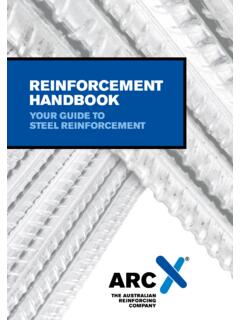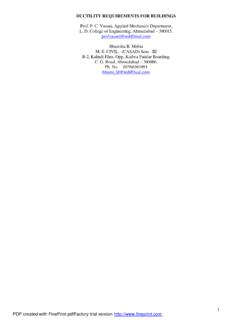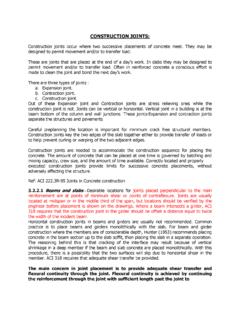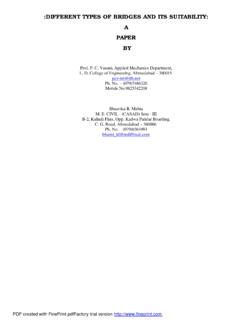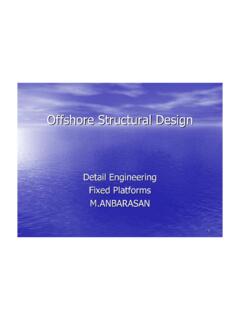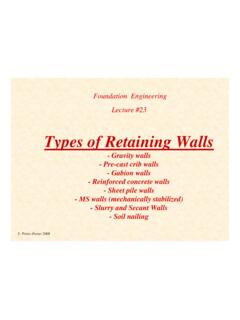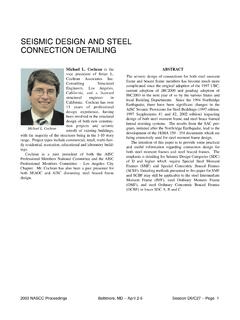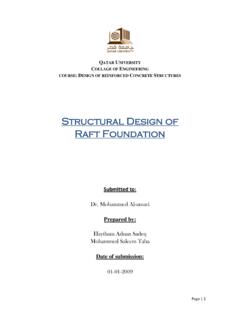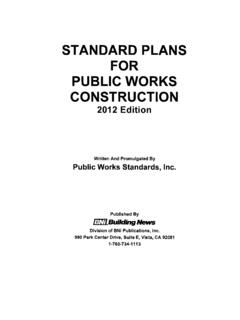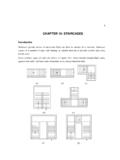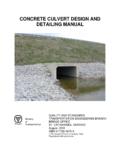Transcription of Design of confinement reinforcement for RC columns
1 2011 THE INDIAN concrete JOURNAL Point of ViewDesign of confinement reinforcement for RC columnsN. SubramanianTransverse reinforcements in columns in the form of hoops, cross-ties, or spirals play an important role in safeguarding the columns , especially when they are subjected to strong earthquakes or accidental lateral loads. They are required in any column-whether they are parts of a moment resistant frame or the gravity system in order for them to deform laterally and provide the required ductility. The current equations for con nement reinforcement in IS 13920 code do not provide consistent level of safety against deformation and damage associated with exural yielding during earthquakes.
2 Hence an equation for the Design of con nement reinforcement for ductile earthquake resistant rectangular and circular columns is suggested for inclusion in the next revision of the code. These equations take into account the various parameters that affect the performance of con ning reinforcement , such as effective con ning pressure or ratio of concrete strength to tie strength, axial load level, uncon ned cover concrete thickness, longitudinal reinforcement and spacing, and curvature ductility factor. Some detailing of these reinforcements is also concrete columns are the main load bearing elements of any structure. They support the beams and slabs and transfer the loads to the foundations. Hence they have to be designed and detailed adequately to resist both gravity and lateral loads.
3 In India columns are more abused than other structural elements; minimum size as per codes not provided, rebars are kinked for better alignment (see Figure 1a), they are made porous due to the dif culty of concreting and vibrating in narrow, tall formwork, they are not cured properly, due to the dif culty of curing vertical elements (see Figure 1b), only minimum transverse reinforcement are provided and only 90o hooks are provided (See Figure 1c). However, we do not witness many failures because the working loads are only about 67% of the failure loads and also due to the partial safety factors of materials. However, during earthquakes or accidental lateral loading, plastic hinges will form in columns and beams.
4 With inadequate Design , detailing or construction, the columns are bound to fail, as we have witnessed in several earthquakes ( , like the ones in Bhuj, and Haiti). In order to prevent plastic hinges to form in columns , traditionally codes suggest designers to adopt the concept of strong column and weak axis , in which columns are proportioned in such a way that the exural capacity of column is at least 20% more (only 10% more as per clause of the draft IS 13920) than the exural capacity of beams meeting the column. It is important to appreciate that during severe earthquakes some column hinging and some yielding of columns will occur even if the strong column-weak beam philosophy is followed. Hence it is important to Design the transverse reinforcement of columns and detail them to provide the required amount of columns of ICJ offer an opportunity to the engineering fraternity to express their views on the current practices in Design , construction and management being followed in the industry.
5 To share your opinion with our readers, you may send in your inputs in about 1500 words via e-mail to INDIAN concrete JOURNAL ..20112 Point of ViewPurpose of transverse reinforcementTransverse reinforcement are specified in Design codes for beams and columns to serve the following four functions: (a) to prevent buckling of longitudinal reinforcing bars, (b) to resist shear forces and to avoid shear failure, (c) to con ne the concrete core to provide suf cient deformability (ductility), (d) to clamp together lap splices-after splitting cracks form parallel to the splices, ties or spirals restrain slip between the spliced bars. Note that none of these functions are effective till the concrete cracks or spalls; All are critical for the column to maintain vertical or lateral capacities under earthquake displacements in the post-yield range.
6 The article addresses mainly the con nement to revise con ning reinforcement provisions of IS 13920In a recent paper Ranjith and Jain outlined the importance of revising the clauses related to con nement reinforcement for columns and shear walls in IS ,2 They suggested that the provisions be revised in line with ACI However it may not be a good idea to revise it based on ACI 318-08 provisions. Even though ACI 318 code is being revised every three years (the 2011 version of the code is due for publication in a few weeks), the particular clause (clause ) of ACI code has not been revised recently!Because the pressure on the sides of the hoops causes the sides of hoops to de ect outward, rectangular hoops are often less ef cient than spirals in con ning the core of concrete column (see Fig.)
7 2 and 3). The equation for required area of rectangular hoops, as given in equation of ACI code is based on the equation for spirals derived by Richart et al in 1929, as shown below4. Based on the results of extensive experimental program, Richart et al, assumed that the strength gain in core concrete as4 ..(1)Where fcc = strength of con ned core concrete , fcp = compressive strength of plain concrete in column (fcp 'c), and fl = passive compressive pressure provided by transverse reinforcement . The Design criterion adopted in ACI 318 for column con nement is based on the premise that con ned columns should maintain their concentric load carrying capacities even after spalling of concrete cover. Thus, equating the concentric capacity of cover concrete to strength gain in the core, we fc'(Ag - Ac ) = fl(Ac - As ).
8 (2)Where fc' is the compressive cylinder strength of concrete , Ag = gross area of column cross-section, Ac= area of concrete core within perimeter transverse reinforcement (commonly taken as centre-to-centre), and As = area of longitudinal steel 2011 THE INDIAN concrete JOURNAL Point of ViewThe lateral pressure fl for spirally reinforced circular column at yield is given byfl ..(3)Where Asp = area of spiral reinforcement , fyt = yield strength of transverse reinforcement , s = centre-to-centre spacing of transverse reinforcement along column height, and h = column sectional fl into equation 2 and dividing both sides by fytAc, ..(4a)Denoting [4 Asp/(sh)] as st and rearranging, we get.
9 (4b)The above equation was adopted in ACI code after dropping the last term and changing the coef cient to , (4c)For large columns , the ratio of cross-sectional area to con ned core area (Ag/Ac) may approach unity, and the above equation results in small values st. Hence a lower-bound expression is provided by setting a limit to the (Ag/Ac) ratio, as (4d)The con nement steel requirements for square and rectangular columns were derived as an arbitrary extension of the above formulae, recognising that rectangular /square hoops are not as effective as spirals. It was assumed that the rectangular /square hoops will be 75 percent as effective as circular spirals. Thus the constants in equation 4c and 4d were changed to give hoops with about one-third more cross-sectional area than those of spirals, to give the following (5a).
10 (5b)Thus the strength enhancement in the core (fcc-fcp) implied by these formula are and flfor circular column with spirals and rectangular or square columnsTHE INDIAN concrete JOURNAL ..20114 Point of Viewrespectively (as against fl as suggested by Richart et al).4 Equations 4d and 5b govern for large-diameter columns , and are intended to ensure adequate exural curvature capacity in yielding ,6 These equations are not new and are present in ACI 318 even in the 1999 or may be in still earlier versions of the that affect the amount of con nement reinforcementThe state of knowledge on concrete con nement has improved substantially since the pioneering work of Richart et al in 1929, and a large volume of experimental data has been generated and a number of improved analytical models have been developed.
